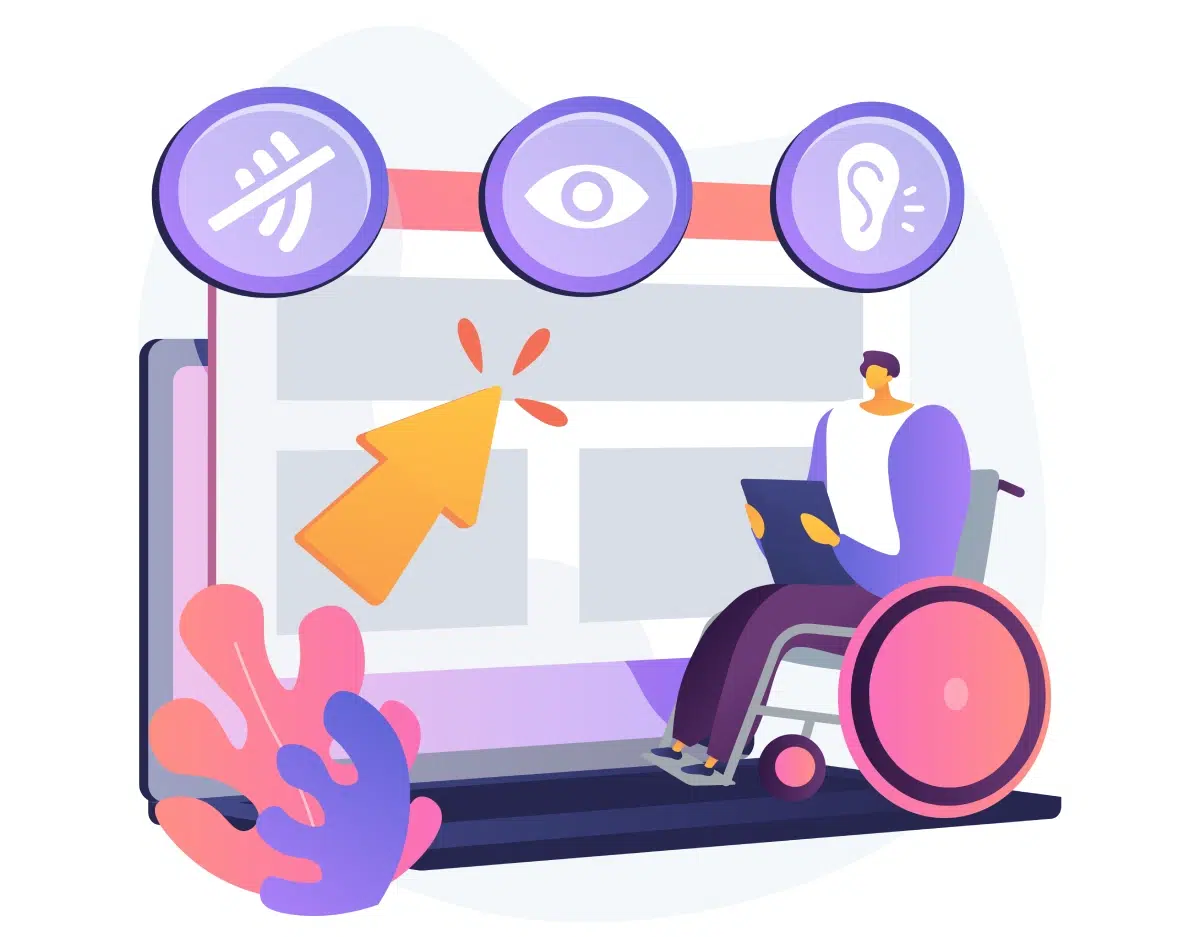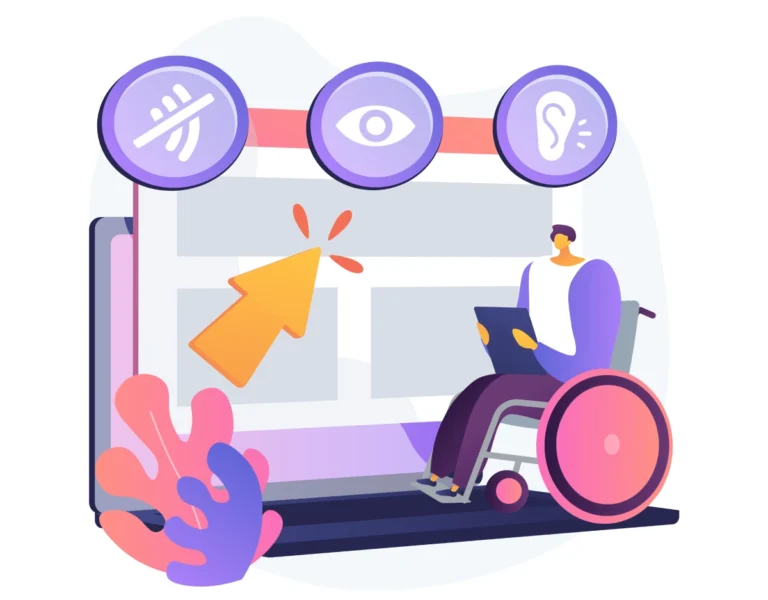Accessibility in web designing has evolved from a compliance checkbox to a fundamental business strategy that drives both social impact and bottom-line results. In 2025, businesses that prioritize inclusive UI/UX designing don’t just serve their existing customers better – they unlock entirely new markets while strengthening their brand design reputation as forward-thinking, socially responsible organizations.
The digital divide affects over 1.3 billion people worldwide who live with disabilities, representing a massive untapped market that accessibility-focused web designing can capture. When businesses integrate inclusive principles into their UI/UX designing and brand design strategies, they create experiences that work better for everyone, not just users with specific accessibility needs.
Understanding accessibility requirements in web designing isn’t just about avoiding legal issues – it’s about building digital experiences that reflect your brand’s values while expanding your customer base. Smart businesses recognize that accessible UI/UX designing creates competitive advantages that extend far beyond compliance, driving engagement, conversion, and customer loyalty across all user segments.
Why Accessibility-First Web Designing Drives Business Success
1. Expanding Market Reach Through Inclusive UI/UX Designing
Accessible web designing opens your business to the $13 trillion annual disposable income controlled by people with disabilities globally. This market expansion through inclusive UI/UX designing represents one of the largest underserved demographics in digital commerce.
Market benefits of accessible web designing:
- Increased customer base through inclusive UI/UX designing that serves diverse needs
- Higher customer loyalty from users who find truly accessible digital experiences
- Enhanced brand design reputation as an inclusive, values-driven organization
- Competitive differentiation in markets where accessibility-focused web designing remains rare
Example: An e-commerce retailer redesigned their checkout process using accessibility-focused UI/UX designing principles, resulting in 35% higher conversion rates across all user groups and $2.3 million in additional annual revenue from previously excluded customers.
2. SEO Benefits of Accessible Web Designing
Search engines favor websites built with accessibility best practices because accessible UI/UX designing typically correlates with clean code, semantic structure, and user-friendly experiences that search algorithms reward.
SEO advantages of accessible web designing:
- Improved site structure through semantic HTML in web designing implementations
- Better mobile experience through responsive UI/UX designing practices
- Enhanced user engagement metrics that boost search rankings
- Cleaner code architecture that supports technical SEO optimization
3. Legal Protection Through Compliant Brand Design
While accessibility lawsuits continue increasing, businesses practicing inclusive web designing and UI/UX designing significantly reduce legal risks while demonstrating good faith efforts toward compliance with evolving regulations.
Risk mitigation through accessible web designing:
- WCAG 2.1 AA compliance reduces legal vulnerability in brand design choices
- Documentation of accessibility efforts in UI/UX designing processes
- Proactive approach demonstrates commitment to inclusive digital experiences
- Cost savings compared to reactive accessibility remediation in web designing
Core Principles of Accessible Web Designing
1. Perceivable Design Elements in UI/UX Designing
Users must be able to perceive information regardless of their sensory abilities. This fundamental principle shapes every aspect of accessible web designing, from color choices in brand design to multimedia implementation.
Perceivability essentials in web designing:
- Sufficient color contrast ratios that meet WCAG standards in brand design
- Alternative text for images and graphics throughout UI/UX designing
- Captions and transcripts for video content in web designing implementations
- Scalable text that remains readable when enlarged in responsive design
Example: A healthcare website improved their brand design color contrast and added comprehensive alt text, resulting in 45% longer average session duration and 28% higher appointment booking conversion rates.
2. Operable Interfaces Through Thoughtful UI/UX Designing
All interface components must be operable by users regardless of their physical abilities. This principle requires careful consideration of navigation, timing, and interaction design in comprehensive web designing strategies.
Operability features in accessible UI/UX designing:
- Keyboard navigation for all interactive elements in web designing
- Sufficient time limits or user control over timed content
- Seizure-safe animations and transitions in brand design implementations
- Clear focus indicators and logical tab order throughout UI/UX designing
3. Understandable Information Architecture
Content and navigation must be understandable to users with cognitive disabilities and varying literacy levels. This principle influences content strategy, UI/UX designing decisions, and overall information architecture in web designing projects.
Understandability factors in web designing:
- Plain language and clear content hierarchy in brand design communication
- Consistent navigation patterns throughout UI/UX designing systems
- Error identification and correction guidance in web designing forms
- Predictable functionality and interface behavior across all touchpoints
4. Robust Technical Implementation
Accessible web designing must work reliably across different assistive technologies and future platform updates. This principle ensures longevity and broad compatibility in UI/UX designing solutions.
Robustness requirements in web designing:
- Semantic HTML markup that supports assistive technology compatibility
- Progressive enhancement in UI/UX designing for varied capability browsers
- Standards-compliant code that adapts to evolving accessibility technologies
- Cross-platform testing across different assistive devices and brand design implementations
Practical Implementation Strategies for Accessible Web Designing
1. Color and Contrast Optimization in Brand Design
Color accessibility extends beyond basic contrast ratios to encompass comprehensive visual communication strategies that enhance both accessibility and overall brand design effectiveness.
Advanced color strategies in web designing:
- 4.5:1 contrast ratio minimum for normal text in UI/UX designing
- 3:1 contrast ratio for large text and graphical elements in brand design
- Color-independent information conveyance in web designing interfaces
- Consistent color usage patterns throughout brand design systems
Implementation tip: Use automated contrast checking tools during UI/UX designing processes, but always validate with real user testing to ensure practical accessibility in web designing applications.
2. Typography and Readability in UI/UX Designing
Accessible typography goes beyond font selection to encompass spacing, sizing, and content structure that supports diverse reading abilities and assistive technologies.
Typography best practices in web designing:
- Minimum 16px base font size for body text in UI/UX designing
- 1.5x line height for improved readability in brand design implementations
- Sans-serif fonts for digital readability in web designing projects
- Logical heading hierarchy that supports screen reader navigation
3. Form Design and User Input Optimization
Forms represent critical conversion points where accessibility failures directly impact business results. Inclusive form design in UI/UX designing dramatically improves completion rates across all user groups.
Accessible form principles in web designing:
- Clear, descriptive labels associated with all input fields
- Error messaging that explains specific problems and solutions in UI/UX designing
- Logical tab order and keyboard navigation throughout form design
- Multi-step forms with clear progress indicators in web designing workflows
Example: A financial services company redesigned their loan application using accessible UI/UX designing principles, increasing form completion rates by 52% and reducing customer service calls by 40%.
Advanced Accessibility Features in Modern Web Designing
1. Motion and Animation Considerations
While motion enhances user experience, accessible web designing requires thoughtful implementation that doesn’t exclude users with vestibular disorders or cognitive processing differences.
Motion accessibility in UI/UX designing:
- Respect for prefers-reduced-motion settings in web designing
- Essential motion only for critical functionality in brand design
- User controls for animation playback in UI/UX designing interfaces
- Alternative static content for motion-dependent information
2. Voice User Interface Integration
As voice technology becomes mainstream, accessible web designing increasingly incorporates voice navigation and control options that benefit users with motor disabilities and enhance overall usability.
Voice accessibility features in web designing:
- Voice navigation compatibility in UI/UX designing systems
- Spoken feedback for important actions and confirmations
- Voice input alternatives for text entry in accessible brand design
- Integration with popular voice assistive technologies
3. Cognitive Load Reduction Strategies
Accessible UI/UX designing minimizes cognitive burden through clear information hierarchy, progressive disclosure, and intuitive navigation patterns that benefit all users while specifically supporting those with cognitive disabilities.
Cognitive accessibility in web designing:
- Simplified navigation with clear pathways in UI/UX designing
- Progressive disclosure to prevent information overload in brand design
- Consistent interaction patterns throughout web designing systems
- Clear feedback and confirmation for user actions
Testing and Validation for Accessible Web Designing
1. Automated Testing Integration
While automated tools cannot catch all accessibility issues, they provide valuable baseline validation for web designing projects and ongoing UI/UX designing maintenance.
Automated testing tools for web designing:
- WAVE browser extension for real-time accessibility auditing
- Lighthouse accessibility scoring in web designing performance reviews
- Color contrast analyzers for brand design validation
- Screen reader simulation tools for UI/UX designing testing
2. User Testing with Diverse Abilities
Real user feedback from people with disabilities provides invaluable insights that automated testing cannot replicate, ensuring practical accessibility in web designing implementations.
User testing strategies for UI/UX designing:
- Include users with diverse disability types in web designing research
- Test with actual assistive technologies used by target audiences
- Gather feedback on brand design accessibility and usability preferences
- Iterate based on real-world usage patterns in accessible UI/UX designing
Business Integration of Accessible Web Designing
1. Accessibility in Digital Marketing Strategy
Accessible web designing enhances the effectiveness of SEO, social media marketing, and PPC campaigns by creating more engaging, discoverable, and conversion-friendly digital experiences.
Marketing benefits of accessible UI/UX designing:
- Improved SEO performance through semantic web designing structure
- Higher engagement rates from inclusive brand design approaches
- Broader audience reach through accessible social media content
- Enhanced PPC conversion rates from optimized landing page UI/UX designing
2. Training and Team Development
Successful accessibility implementation requires organization-wide understanding of inclusive design principles, from web designing teams to content creators and brand design strategists.
Team education for accessible web designing:
- Regular accessibility training for UI/UX designing teams
- Brand design guidelines that incorporate accessibility standards
- Content creation training for accessible writing and media production
- Cross-functional collaboration between web designing and marketing teams
Final Thought
Accessibility in web designing represents far more than compliance – it’s a strategic opportunity to create more inclusive, engaging, and profitable digital experiences. When businesses integrate accessibility principles into their UI/UX designing and brand design strategies, they don’t just serve people with disabilities better; they create superior experiences for all users while expanding their market reach and competitive positioning.
The future belongs to businesses that recognize accessibility as a driver of innovation rather than a constraint on creativity. Through thoughtful web designing that prioritizes inclusion, companies build stronger brands, reach broader audiences, and create digital experiences that truly reflect their values while delivering measurable business results.
Whether you’re launching a new website or optimizing existing digital touchpoints, accessibility-focused web designing and UI/UX designing create lasting competitive advantages that compound over time. The question isn’t whether your business can afford to prioritize accessibility – it’s whether you can afford not to in an increasingly inclusive digital marketplace.
Ready to transform your digital presence with accessibility-first web designing that drives both social impact and business results? Our expert team specializes in inclusive UI/UX designing and brand design strategies that expand your market reach while creating exceptional user experiences for all. Book a free consultation call today to discover how accessible web designing can accelerate your growth, or explore our comprehensive digital marketing services including SEO, social media management, PPC, and branding to create a unified, inclusive online presence.





